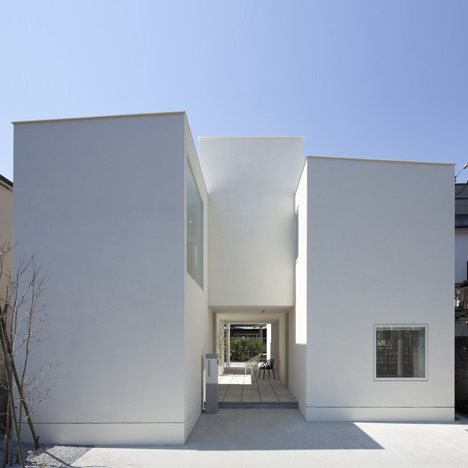This Tokyo house by Japanese architects Aida Atelier comprises a cluster of four white-rendered blocks that support an elevated fifth block above a central patio.
Completed in collaboration with Nagoya City University architecture and design research team Kuno Lab, the two-storey house is closely surrounded by other houses so the architects wanted to locate the private patio at the centre.
Four separate rooms on the ground floor occupy the four corners of the site, accommodating bedrooms for each of the house's three residents and an entrance hall.
Staircases inside each of these rooms lead up to a central living and dining room on the first floor, which bridges the blocks and shelters the patio below.
The house is named Portico, after the traditional Italian porch with columns and a canopy.
Other houses we've featured from Japan this month include one with an exterior like a rockface and one with no walls.
See more stories about Japanese houses »
Photography is by Tatsuya Noaki.
Here's some more information from the architects:
Portico
Aida Atelier + Kuno Lab.
This is a house for a family of three in a residential neighborhood of suburban Tokyo. Surrounded by properties subdivided through generations of time, this site maintains its original state. Albeit having plenty of land relative to others, six different adjacent properties with homes built tightly to the boundary leaves the project site with a condition, which limits the project from fully enjoying the advantage of having a deep street frontage with the river.
Such meticulous condition of uneven contextual grain at a time of transition from continuing growth and expansion, it shall undoubtedly be emerged in mass in the residential neighborhood. As such, the theme for this project is the approach to architecture and exterior space that receives undulating peripheral density.
Here, three rules particularly regarding the exterior space were set. The first rule is to not confine itself from its surroundings. Instead of self concluding within the property unit much like a courthouse, create a coordinated environment with adjacent exterior space of large and small, buffing those varying density while sharing the spatial openness, circulating air, and natural light.
Next rule is to avoid creating a cul-de-sac. In other words, having an exterior space free from stagnation that also partially takes on an important visual and physical element of the project. This space is not a residual space of the inside, but an active part of the house that simultaneously exists as an integral section to the neighborhood.
Finally, the last rule is to conceive this exterior space as a volume, and not a plane. Re-conceiving the space typically left blank in upper floor plan drawing as a conceptual "garden", it materializes the external space forming another invisible volume within the property. What these three rules deduce to is a layout and a form with an approximating interior and exterior air volume that alternate in both horizontal/vertical dimensions.
The naming has obvious connections to the classical style it originated. The reason for using the urban vocabulary is in our anticipation towards to the future outcome of a suburban residential area in Japan. It is no coincidence if the exterior form appears to be an intermediate between a single house and a housing complex.
Name: Portico
Program: Single Family Residence
Location: Tokyo, Japan
Design Team: Tomoro Aida + Toshimitsu Kuno + Shinpei Uehara + Tomoki Nagase (Aida Atelier, Inc. + Kuno Lab. / Nagoya City Univ. Graduate School of Design and Architecture)
Structural Engineer: Takeyuki Gaino (G.DeSIGN)
Construction: Home Builder, Inc.
Design: 09/2009 - 09/2010 (12 months)
Construction: 09/2010 - 03/2011 (6 months)
Structure: Wooden Frame
Floor: Two Levels
Site Area: 179.07m2
Floor Area: 1st Floor 56.39m2 / 2nd Floor 78.66m2 / Total 135.05m2
Height: 7,116mm

